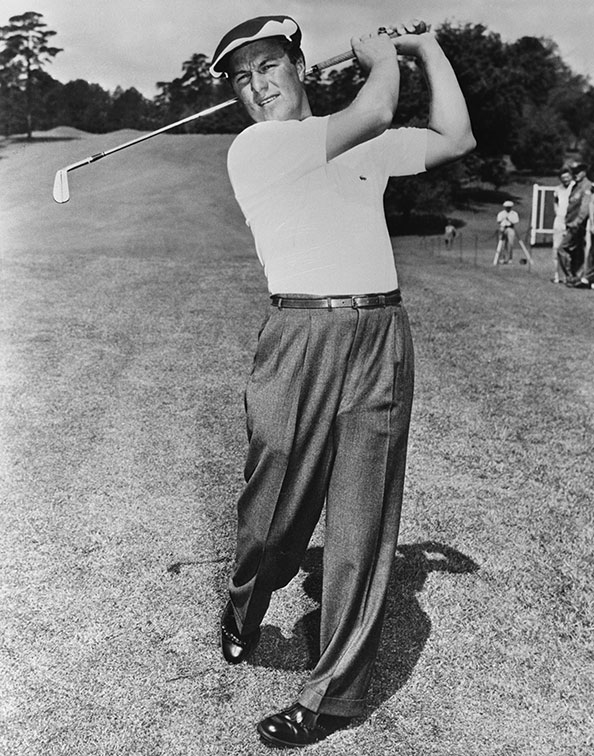Once upon a time, Australia had a genuine passion for manufacturing. We produced all manner of things, including golf clubs.
Younger generations mightn’t realise Australia was a central hub of club manufacturing. “The best in the world,” boasts PGA professional Tommy Moore, who established the golf heritage movement in Australia.
Three clubmakers dominated the local scene through until the 1970s. Slazenger, PGF and Spalding were iconic brands that built their reputations upon “the precision of making clubs, the attention to detail, where every club was perfect in a set”.
Arnold Palmer, Jack Nicklaus and Gary Player even put these clubs in their bags during tournament appearances in Australia.
“They certainly did,” says Moore. “In the 1950s, the ’60s and ’70s, the US clubs were lauded around the world as the best. But when it was tournament time here, you would go to Slazenger’s and see anything up to seven of these overseas stars waiting to get [fitted] with one of our golf sets.”
The arrival of Alex ‘Sandy’ Faichney from Scotland in 1948 was a boon for local clubmaking. He came to work for Slazenger Australia and “developed these clubs which were absolutely astonishing” says Moore. Nicklaus was most insistent that Faichney come to America and work for him.
Lee Trevino took home a set of Faichney’s clubs and won the 1971 and 1972 British Open titles using a bag of Slazenger irons. However, he covered the Slazenger name with strips of adhesive tape because he was contracted to another equipment manufacturer (above).
Slazenger was an offshoot of the parent company in Britain and had a formidable presence in Australia.

In four of his five British Open triumphs, Peter Thomson used Dunlop irons made by Slazenger. (Dunlop bought out Slazenger in the 1980s.)
“Nearly all the forgings for Slazenger were done up in the small arms factory at Lithgow. They would do the forgings and send them down, very rough, and then they would be finished down at Bowden Street, Alexandria,” Moore says.
Once in Sydney, the forgings had to be polished and knocked into correct lie and loft before the clubs could be stamped. Of course, all that took time and great expertise.
In those days, there was a tariff on imported clubs of about 47 per cent. International clubs were terribly expensive and that’s why a clubmaking industry flourished in Australia. But as tariffs were removed, the incentive to produce clubs diminished.
Thomson, Kel Nagle and Greg Norman were all associated with what’s now known as PGF at one time in their careers. Established in 1932 as East Brothers, the company later merged with Chesterfield to become Precision Golf Forging (PGF) in the 1950s.
PGF was responsible for assisting the careers of many young professionals. In the late 1960s, David Graham moved to Sydney and took a job working for PGF owner Clare Higson in order to pay off debts from a failed club professional business in Tasmania.
Under the stewardship of Higson, who was a brilliant marketeer, PGF specialised in what was called drop forgings. A piece of steel would be placed in the bottom of this “dirty big machine” and “this bloody thing would come down with an almighty bang and punch (the clubhead) out”.
By the 1980s, clubmakers had switched to the lost wax system of pouring molten steel into moulds. More formally known as investment casting, pioneered by PING’s Karsten Solheim, it produced more consistent heads while the cavity could be deeper and more detailed than what could be achieved through forging. Nevertheless, Slazenger quit the clubmaking scene in the 1990s. Manufacturing costs had become prohibitive and the big American companies were benefitting from economies of scale as they put vast amounts of money into research, development and marketing.
PGF was still producing quality clubs at the turn of the century. Paul Gow proudly endorsed the brand during his first year on the US PGA Tour in 2001. Incidentally, when equipment representatives approached Gow on the practice range to enquire about the acronym PGF, he would reply: “Paul Gow Fashion.”
Since 2011, PGF has been owned by Walkinshaw Sports, a name intrinsically linked with Australian V8 Supercars.
Unlike the automobile industry, which survived on government subsidies for years, local golf club manufacturing companies had no such largesse.
Apart from boutique companies such as Piranha Golf, the clubmaking business in Australia has all but disappeared.




